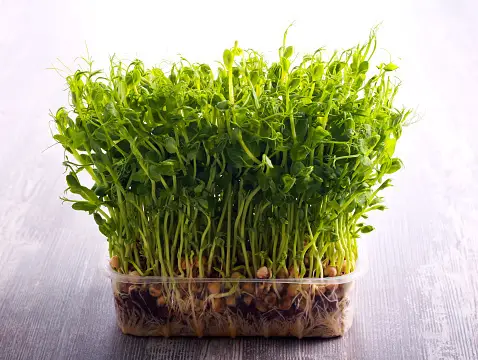Are microgreens a fancy way of saying sprouts?
Because both microgreens and sprouts are harvested in the early stages of growth — a few days after germination — they are often vaguely referred to as the same.
They may appear to be the same thing, but in reality, they are not. As such, you must be aware of the difference between microgreens and sprouts. Here, we provide an overview of microgreens.
Similarities:
- Both plants are grown using the same seeds, and they require water to break dormancy.
- Mold can appear in both cases if handled incorrectly.
- Before planting the seeds, they could be pre-soaked with clean water.
- Both can be consumed as food on a low FODMAP diet.
Differences:
- Microgreens can be harvested in 7-14 days; whereas sprouts’ harvest time is in 3-5 days time.
- Sprouts or infant plants are 2 to 3 inches in length; a microgreen is four to seven inches.
- Microgreens are grown either hydroponically or in soil. Sprouts are grown hydroponically or without soil.
- A sprout cannot form true leaves, but only the seed leaves (cotyledon); microgreens can.
- For sprouts, the entire plant is eaten (seed, root, stem, and seed leaves); microgreens are separated above the ground, and only the leaves and stems are eaten.
- Microgreens have a more nutritional punch or vitamin content than sprouts.
- Raw sprouts are more dangerous to consume than raw microgreens.
- Growing sprouts do not require indirect sunlight; the growth of microgreens needs a light source.
- Microgreens require good air ventilation while sprouts do not.
- A Sprout is good for topping salads and stir-fry; Microgreens are suitable for garnish, soup, sandwiches, and various dishes.
- Microgreens offer many types in contrast to sprouts, which have only a limited selection.
- Varieties of sprouts contain less fiber content than microgreens.
- Refreshing sprouts usually cost less than nutritious microgreens.

Growth Period
One of the major differences between microgreens and sprouts is the growth period. Typically, soil sprouts are grown for 3 to 5 days until harvest, however, some sprouts are grown a little longer until day six to seven as well.
For nutritious microgreens, the stage of growth typically takes 7-14 days to grow. Farmers prefer to grow herb microgreens for as long as 25 days, or until their first true leaves appear, for a stronger taste. In particular, herb types are the slow growers, such as lovage and oregano.
Length
It depends on the species, the growth rate, and the method in which it is harvested. The roots will seek out light naturally to develop longer, more slender shoots if you maintain microgreens longer in a blackout dome.
Growing Method
Growing various types of sprouts do not require extra nutrients. Rather, the nutrients in the endosperm are used by sprouts to grow. Since water is the only requirement, hydroponic media is preferable. Coconut coir, paper towels, and mason jars are the usual methods people use to grow sprouts.
Microgreens, by contrast, need more nutrients from the soil to grow. Using the soil method is then preferable. While you can still use hydroponics, such as substrate mats, you ought to provide the nutrients to increase the flavor of microgreens.
Appearance
Seed leaves are the first set of leaves that emerge from a seed. Before the true leaves form, sprouts are harvested. For microgreens, you’ll often see real leaves as they expand. A seed leaf may have distinct differences in size and shape.
Growing Conditions and Risks
As a general rule, sprouts are grown in a damp, poorly ventilated, and low-light environment, which also fosters mold and bacterial growth. Because of this, sprouts should not be consumed in raw diets. Raw sprouts have been responsible for many foodborne illnesses like food poisoning from E. Coli.
Microgreens are grown in environments that are moist but not soggy, well ventilated, and exposed to lots of light, thus fewer health issues arise. Even though people love to consume them raw, it’s safest to cook them lightly before serving.
Conclusion
Essentially, sprouts are just newly germinated seeds, while microgreens are 1 to 2 week-old seedlings. As for sprouts, they tend to grow more like a fungus, since we provide high humidity, enclosed areas, and low light during the growing process — like the mason jar. In contrast, microgreens grow more like a plant. They absorb nutrients directly from the microgreen seeds, soil, and sunlight.

